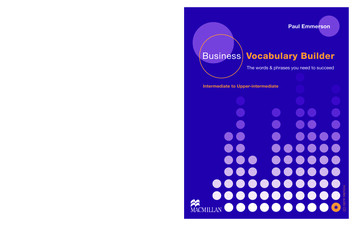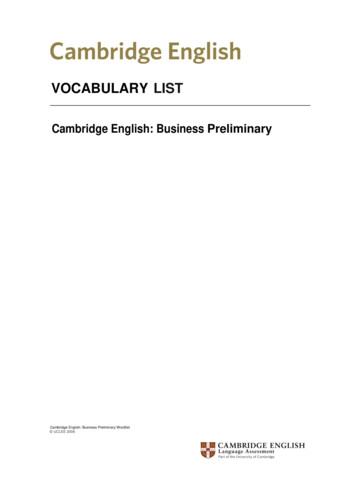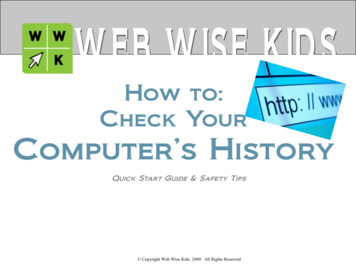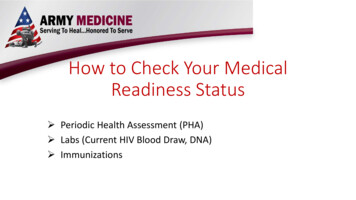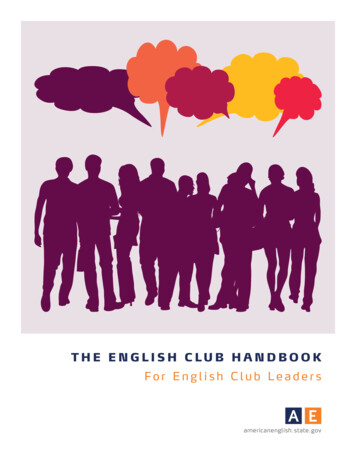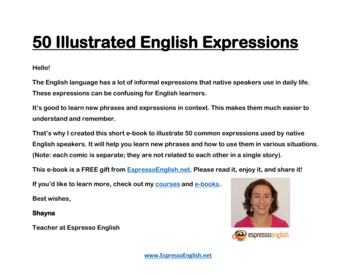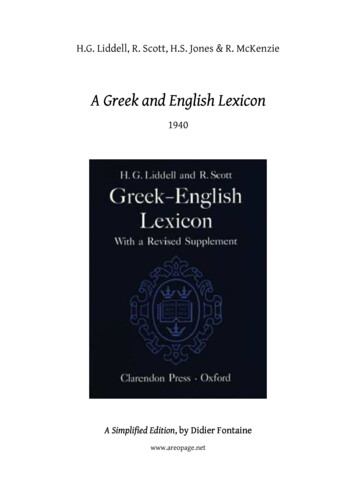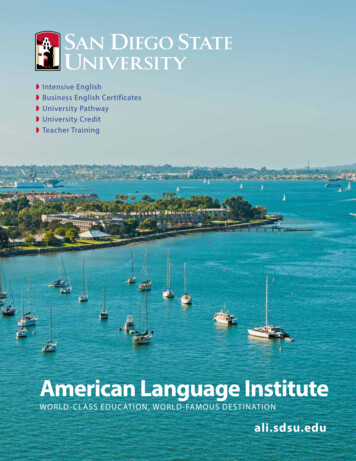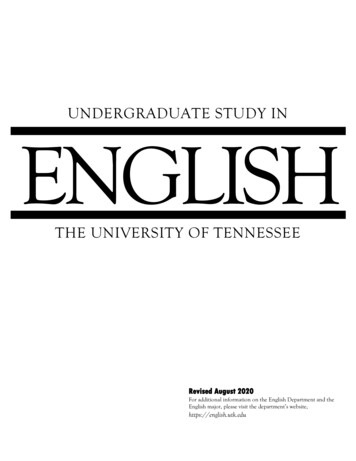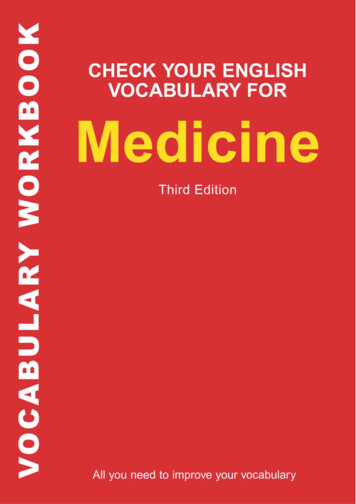
Transcription
CHECK YOUR ENGLISH VOCABULARY FORMEDICINEthird editionA & C Black 폷 London
www.acblack.comFirst published in Great Britain 1995Second edition published 2000Third edition published 2006A & C Black Publishers Ltd38 Soho Square, London W1D 3HB Peter Collin Publishing 1995, 2000 A & C Black Publishers Ltd 2006All rights reserved.No part of this publication may be reproduced inany form without the permission of the publishers.A CIP entry for this book is available from the British LibraryISBN-10: 0 7136 7590 XISBN-13: 978 0 7136 7590 0eISBN-13: 978-1-4081-0238-1Text typeset by A & C BlackPrinted in Italy by LegoprintA & C Black uses paper produced with elemental chlorine-free pulp,harvested from managed sustainable forests.
IntroductionThe worksheets in this workbook contain a variety of exercises appropriate for studentsrequiring a working knowledge of English medical terminology. The worksheets can be usedeither for self-study or in the classroom and can be completed in any order. Several have'extensions': short classroom exercises based on the language in the main exercise. All thequestions within this workbook are based on the A & C Black Dictionary of Medical Terms,fourth edition (ISBN 0 7136 7603 5).This workbook is aimed at students with at least an intermediate level of English. However,many people who work in medicine have to read in English on a regular basis; students witha more basic level of English may therefore already have the passive vocabulary to handlemany of the exercises.Specialist vocabularyIt is important to appreciate that 'knowing' specialist vocabulary involves more than simplyrecognising it. You can understand the meaning of a word when reading or listening and yet beunable to remember that same word when speaking or writing.You may remember the word, but use it incorrectly. This can be a grammaticalproblem, like knowing that 'fracture' can be used both as a noun and as a verb. Orit may be a question of collocation: a surgeon makes an incision during an operation,but when he wants a piece of bread he simply cuts it.Then there is the question of the sound of the word. Can you pronounce it? And doyou recognise it when you hear it pronounced?For these reasons - memory, use and sound - it is important that students practise specialistvocabulary so that they can learn to use it more confidently and effectively. The exercises inthis workbook will help students to expand their knowledge and use of medical vocabulary.Using the Dictionary of Medical TermsAll of the vocabulary taught or practised in this workbook is in the A & C Black Dictionary ofMedical Terms. The Dictionary of Medical Terms gives definitions in simple English whichstudents can read and understand. Many of the examples and definitions in the workbookare taken directly from the dictionary. Students should have a copy of the Dictionary ofMedical Terms for referring to when completing the exercises; using the dictionary is anessential part of successful language learning.Structure of a Dictionary of Medical Terms entryEach entry within the dictionary includes key elements that help a student understand thedefinition of the term and how to use it in context. Each term has a clear example, and partof speech. This is followed by example sentences and quotations from newspapers andmagazines that show how the term is used in real life. These elements of the dictionary areused to create the questions within this workbook.Vocabulary Record SheetAt the back of the book is a Vocabulary Record Sheet. Recording useful vocabulary in amethodical way plays a key role in language learning and could be done, for example, at theend of each lesson. The Dictionary of Medical Terms is a useful tool for ensuring that thepersonal vocabulary record is accurate and is a good source for example sentences to showhow words are used, as well as for notes about meaning and pronunciation, etc.
Workbook contentsPage TitleDescriptionModeLinking each set of four words with one other wordSelf-studyForming nouns from list of verbs; rewriting sentencesusing noun forms instead of verbsCombining words from two lists to make two-wordexpressions that fit the definitionsMultiple choice: choosing correct plural forms of singularnounsRewriting sentences using adjective forms instead ofnounsLinking each verb with a noun to make a 'partnership';using the 'partnerships' to complete sentencesSelecting the correct prefix for each adjective to create anopposite; using the adjectives to complete sentencesExtension: working with a partner to test one anotherSelf-studyWORD-BUILDING13Word association 1:missing linksWord formation:nounsTwo-word expressions4Plural formation5Word formation:adjectivesWord association 2:partnershipsOpposites 1: udySelf-studyWord formation: verbs Making verb forms from list of nouns; writing sentences Self-studyusing the verbsSelf-studyWord association 3:Finding words in a mind map that fit definitions;mind mapsdesigning mind mapsPARTS OF SPEECH1011NounsAdjectives 1Sentence completionSentence completionSelf-studySelf-study121314Adjectives 2Verbs 1Verbs 2Sentence completionMatching verbs with their correct definitionsMatching verbs with their correct e completionSelf-study1617Verbs: past tense regular verbsVerbs: mixed tensesPhrasal verbsSentence completionSentence completionExtension: working with a partner to write a dialogueusing phrasal verbsSelf-studySelf-study1819Verbs: tionsChanging sentences from active to passive tenseIdentifying adverbs in sentences and swapping adverbsaround so that each sentence makes senseCorrecting sentences with deliberate mistakes inthe prepositionsIdentifying three-syllable words and classifying by theirpronunciationExtension: practising the dialogues with a partnerCompleting sentences using four-syllable words;classifying four-syllable words by their pronunciationIdentifying present tense verbs and classifying by theirpronunciationExtension: working with a partner to identify pluralnouns in each pronunciation categorySelf-studyPair workIdentifying past tense verbs and classifying by N21Word stress 122Word stress 223Present simple24Past tenseSelf-studyPair work
Page TitleDescriptionMode26VOCABULARY IN CONTEXTGood adviceMatching half-sentences together to make completesentencesExtension: writing pieces of medical advice with apartnerMultiple meaningsClassifying meanings27Odd one out28Body parts - categories Deciding which category each body part belongs toSelf-study29Opposites 2Matching words with opposite meanings; insertingcorrect opposites in sentencesExtension: working with a partner to test one anotherSelf-studyStating what abbreviations stand forExtension: working with a partner to test one anotherSymptoms & common Checking meanings of words; matching descriptions toillnesses 1names of illnessesSymptoms & common Matching formal and informal names of illnesses;completing conversations by using informal names ofillnesses 2illnessesExtension: practising conversations with a partnerSelf-studyPair workSelf-study33DiagnosisSelf-studyPair work34How it works35Instruments andequipment2530313236Identifying word that is different to others in each setAbbreviationsChemistryIdentifying each disease or illness from its descriptionExtension: writing a description of a disease or illnessand testing a partnerMatching half-sentences together to make completesentencesMatching each instrument and item of equipment withits correct descriptionExtension: working with a partner to test one anotherSelf-studyPair workSelf-studySelf-studyPair workSelf-studyPair workSelf-studySelf-studyPair workMatching symbols of chemical elements and compounds Self-studywith correct names and descriptionsExtension: working with a partner to test one another Pair workPUZZLES & QUIZZESSolving anagrams by reading clues and putting lettersin orderSolving crosswordSelf-studyCompleting crossword by working with partner anddefining wordsSolving anagrams by reading clues and putting lettersin orderFinding words hidden in letters using clues listedPair workCommunicativecrossword 2Parts of the bodycrossword 2Completing crossword by working with partner anddefining wordsSolving crosswordPair work46Gap fill crosswordSelf-study4748Communicativecrossword 3Completing crossword with missing words fromsentencesCompleting crossword by working with partner anddefining words49Quiz50Vocabulary RecordSheetAnswering questionsExtension: writing a quiz with a partnerRecording new vocabulary, definitions and termsSelf-studyPair workSelf-study51Answer key37Anagrams 138394041Parts of the bodycrossword 1Communicativecrossword 1Anagrams 242Word search434445Answers to all Pair work
Unit 0000Usingthe workbookMost students find it easier to assimilate new vocabulary if the words are learned in related groups, ratherthan in isolation. For example, words frequently occur in the same context as their opposites and, as such, itmakes sense to learn the pairs of opposites together (see worksheets on pages 7 and 29). Similarly, mindmaps encourage students to look for connections between words (see worksheet on page 9). The exercisesand activities in this workbook have all been grouped into sections. These sections practise different elementsof medical vocabulary, enabling the student to gain a fuller understanding of the words learnt.The first section, Word-building (pages 1-9), encourages the student to identify links between words and tolearn words that are morphologically related (for example, verbs and nouns which have the same stems).Within the Parts of Speech (pages 10-20) section, the emphasis is on understanding meanings and how touse terms in their correct grammatical forms. The worksheets in the third section practise the Pronunciationof medical vocabulary (pages 21-24). The section Vocabulary in Context (pages 25-36) includes topicspecific exercises such as identifying diseases and illnesses from their descriptions. The activities in the lastsection, Puzzles & Quizzes (pages 37-49), expand students' knowledge and use of vocabulary in a fun way.Communicative crosswordsIncluded in the last section are three communicative crosswords. These are speaking exercises where studentscomplete a half-finished crossword by exchanging clues with a partner. There are two versions of thecrossword: A & B. The words which are missing from A are in B, and vice versa. No clues are provided: thestudents' task is to invent them. This is an excellent exercise for developing linguistic resourcefulness; inhaving to define words themselves, students practise both their medical vocabulary and the important skill ofparaphrasing something when they do not know the word for it.Using Communicative crosswords in the classroomStage 1 - Set-up. Divide the class into two groups - A and B - with up to four students in each group. Giveout the crossword: sheet A to group A, sheet B to group B together with a copy of the Dictionary of MedicalTerms. Go through the rules with them. Some answers may consist of more than one word.Stage 2 - Preparation. The students discuss the words in their groups, exchanging information about thewords they know and checking words they do not know in the Dictionary of Medical Terms. Circulate,helping with any problems. This is an important stage: some of the vocabulary in the crosswords is quitedifficult.Stage 3 - Activity. Put the students in pairs - one from group A and one from group B. The students helpeach other to complete the crosswords by giving each other clues.Make sure students are aware that the idea is to help each other complete the crossword, rather than toproduce obscure and difficult clues.-What's one down?It's a person who works in a hospital.A doctor?A sort of doctor. He does operations.A surgeon?Yes, that's right.A AA AB BB BStudents work in groups,checking vocabularyAlternatively, students can work in small groups, each group consisting of two As and two Bs and using thefollowing strategies:i)defining the wordii)describing what the item looks likeA BA Biii)stating what the item is used foriv)describing the person's rolev)stating what the opposite of the word isA BA Bvi)giving examplesvii)leaving a gap in a sentence for the wordStudents work in pairs,viii)stating what the word sounds like.co-operating to solvetheir crosswordsFor reference see A & C Black Dictionary of Medical Terms (0 7136 7603 5).
Word association 1: missingUnit 0000linksEach of the sets of four words below can be linked by one other word. All the words arerelated to medical matters. What are the missing words? Write them in the centre of assdrops6.bloodbetamembranebody1For reference see A & C Black Dictionary of Medical Terms (0 7136 7603 5).
Unit 0000Wordformation: nounsA fast way to expand your vocabulary is to make sure you know the different forms of thewords you learn.Exercise 1. The words in this list are all verbs. What are the noun forms? Write them in thesecond column. The first one has been done for you as an bstructExercise 2. First, check your answers to Exercise 1 in the key. Then rewrite the sentencesbelow, changing the verbs (which are in bold) to nouns. Do not change the meaning of thesentences, but be prepared to make grammatical changes if necessary. The first one hasbeen done for you as an example.1. I diagnosed that the patient had a heartcondition.My diagnosis was that the patient had a heartcondition.9. We found that the tis
of medical vocabulary, enabling the student to gain a fuller understanding of the words learnt. The first section, Word-building (pages 1-9), encourages the student to identify links between words and to learn words that are morphologically related (for example, verbs and nouns which have the same stems). Within the Parts of Speech (pages 10-20) section, the emphasis is on understanding .
